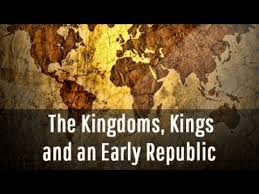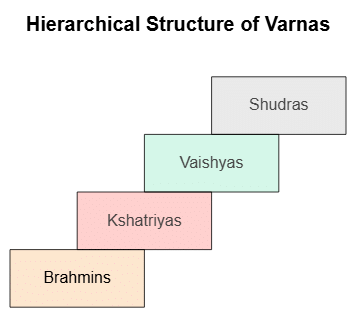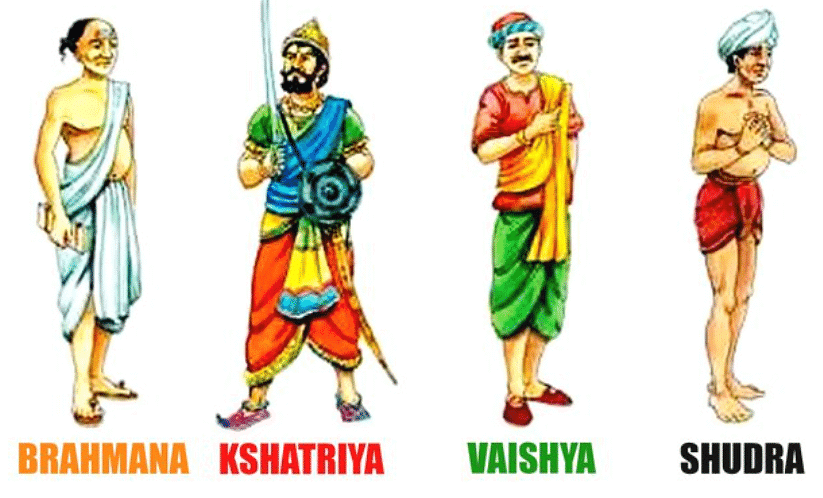Kingdoms, Kings & an Early Republic Summary Class 6 Social Science Chapter 5

How some men became rulers?
- Around 3000 years ago, some men became recognised as rajas by performing very big sacrifices.
- The later rajas gained recognition by performing very big sacrifices.
- Ashvamedha or a horse sacrifice was an important ritual for a raja.
- The raja who organised the sacrifice was recognised as being very powerful, and all those who came brought gifts for him.

Varnas
- The priests divided people into four groups called Varnas.
- According to them, each Varna had a different set of functions.
- These groups were decided on the basis of birth.

- Brahmin: They were expected to study and teach the Vedas, perform sacrifices and receive gifts.
- Kshatriyas: They were the rulers and were expected to fight battles and protect people.
- Vish or the Vaishyas: They were expected to be farmers, herders and traders. Both the Kshatriyas and the Vaishyas could perform sacrifices.
- Shudras: They had to serve the other three groups and could not perform any rituals. Often, women were also grouped with them. They were not allowed to study the Vedas.
Janapadas
- The rajas who performed these big sacrifices were recognised as being rajas of janapadas.

- The word janapada literally means the land where the Jana set its foot and settled down.
- Archeologists found that in janapadas, people lived in huts, kept cattle and other animals. They also grew a variety of crops — rice, wheat, barley, pulses, sugarcane, sesame and mustard.
- They made earthen pots. Some were grey and others were red.
A special type of pottery found at these sites is known as Painted Grey Ware.

Mahajanapadas
- About 2500 years ago, some Janapadas became more important than others and were known as Mahajanapadas.
- Most mahajanapadas had a capital city, many of these were fortified which means that huge walls of wood, brick or stone were built around them.
Taxes
- Rulers of the mahajanapadas needed more resources for building huge forts and maintaining armies.
- The started collecting regular taxes.
- Taxes were collected from farmers, craft persons, herders, traders, hunters as per their skills.
Changes in agriculture
- The growing use of iron ploughshares helped in more grain production.
- People began transplanting paddy which meant that instead of scattering seeds on the ground, from which plants would sprout, saplings were grown and then planted in the fields. This led to increased production, as many more plants survived.
A closer look — (a) Magadha
- Magadha became the most important mahajanapada in about two hundred years.
- Many rivers such as the Ganga and Son flowed through Magadha which helped in transport, water supplies and making the land fertile.
- Two powerful rulers of Magadha were Bimbisara and Ajatasattu.
- The first capital of Magadha was Rajagriha in Bihar and the second was Pataliputra.
A closer look — (b) Vajji
- Vajji, with its capital at Vaishali (Bihar), was under a different form of government, known as gana or sangha.
- In a gana or a sangha there were many rulers, each one was known as a raja.
- The rajas performed rituals together and met in assemblies.
- Women, dasas and kammakaras could not participate in these assemblies.
- Both the Buddha and the Mahavira belonged to ganas or sanghas.
- The last of the sanghas were conquered by Gupta rulers around 1500 years ago.
Some Important Questions
Q1. Why did rajas build large and tall walls around the cities?
Ans: Rajas built tall walls to show their power and wealth. The walls also helped them control their land and the people inside.
Q2. Write a short note on the important rulers of Magadha.
Ans: Bimbisara and Ajatasattu were powerful rulers who expanded Magadha's power. Mahapadma Nanda also ruled and extended his control to the north-west. Rajagriha was the capital of Magadha, later moved to Pataliputra.
Q3. What was the Ashvamedha?
Ans: The Ashvamedha was a horse sacrifice ritual where a horse roamed freely, and if it entered another kingdom, the ruler had to either stop it or let it pass. Letting it pass showed they accepted the power of the raja performing the ritual. Those invited to the ceremony gave gifts, recognizing the raja's power.
|
297 videos|1066 docs|204 tests
|
FAQs on Kingdoms, Kings & an Early Republic Summary Class 6 Social Science Chapter 5
| 1. How did early rulers gain power in ancient times? |  |
| 2. What role did warfare play in establishing kingdoms? |  |
| 3. How did the concept of kingship change over time? |  |
| 4. What were the responsibilities of a ruler in ancient kingdoms? |  |
| 5. How did trade and economy influence the rise of rulers? |  |

















